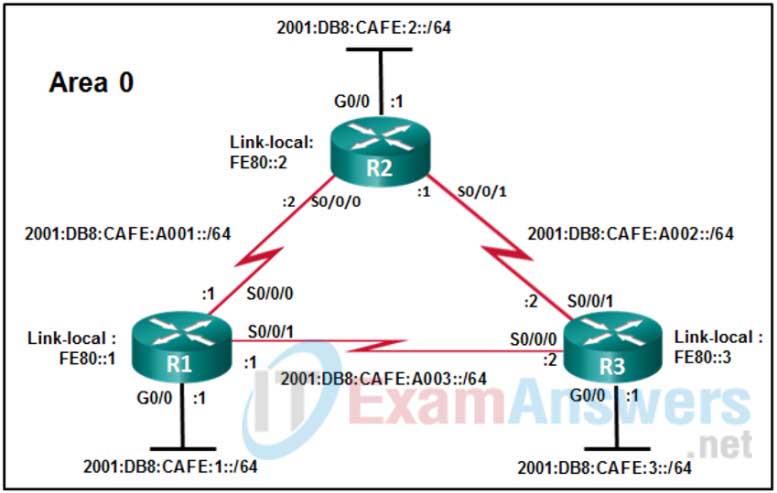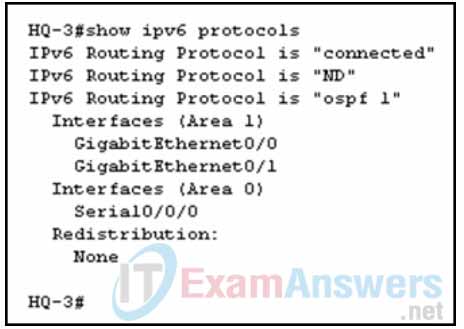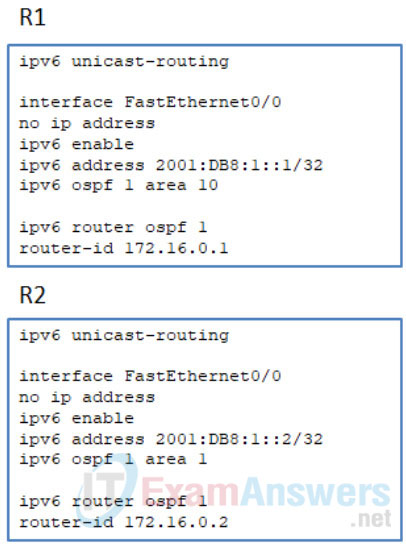1. Which command will verify that a router that is running OSPFv3 has formed an adjacency with other routers in its OSPF area?
- show running-configuration
- show ipv6 ospf neighbor
- show ipv6 route ospf
- show ipv6 interface brief
2. Refer to the exhibit. Which would be chosen as the router ID of R2?

- 2001:DB8:CAFE:2::/64
- LLA: FE80::2
- 2001:DB8:CAFE:A001::/64
- The router ID has to be manually configured.
3. A network engineer is troubleshooting a single-area OSPFv3 implementation across routers R1, R2, and R3. During the verification of the implementation, it is noted that the routing tables on R1 and R2 do not include the entry for a remote LAN on R3. Examination of R3 shows the following:
- that all interfaces have correct addressing
- that the routing process has been globally configured
- that correct router adjacencies have formed
What additional action taken on R3 could solve the problem?
- Enable the OSPFv3 routing process on the interface connected to the remote LAN.
- Use the network command to configure the LAN network under the global routing process.
- Force DR/BDR elections to occur where required.
- Restart the OPSFv3 routing process.
4. An administrator is troubleshooting OSPFv3 adjacency issues. Which command would the administrator use to confirm that OSPFv3 hello and dead intervals are matching between routers?
- show ipv6 ospf interface
- show ipv6 ospf
- show ipv6 protocols
- show ipv6 ospf neighbor
5. An administrator is troubleshooting an OSPFv3 network and wants to view the PID, the RID, the reference bandwidth, and the area parameters for both IPv4 and IPv6 address families. Which single command can be used to display the information?
- show ip protocols
- show ospfv3
- show ipv6 ospf database
- show ipv6 ospf
6. Refer to the exhibit. What type of OSPF router is HQ-3?

- an ABR.
- an ASBR
- an OSPF internal router
- an OSPF edge router
7. Which command will verify that a router running OSPFv3 has received a redistributed default static route from another OSPFv3 router?
- default-information originate
- redistribute static
- show ipv6 route
- show ip route
8. A network administrator has enabled single-area OSPFv3 on a router via the ipv6 router ospf 100 command. Which command will enable this OSPFv3 process on an interface of that router?
- R1(config-router)# network 192.168.10.0 0.0.0.255 area 0
- R1(config-if)# ipv6 ospf 0 area 100
- R1(config-if)# ipv6 ospf 100 area 0
- R1(config-router)# network 192.168.10.0 0.0.0.255 area 100
9. After implementing an IPv6 network, the administrator notices that the OSPFv3 process is not starting on the routers. What could be the problem?
- The routers are configured with the default priority.
- Authentication was not implemented between the routers.
- No router IDs are configured on the routers.
- The routers were not configured with the network command.
10. Which command can be used by an administrator to display a list of interfaces that are enabled for OSPFv3?
- show ipv6 ospf
- show ipv6 neighbor
- show ipv6 route ospf
- show ipv6 protocols
11. Which OSPF LSA type provides information about IPv6 address prefixes associated with a transit network by referencing a network LSA?
- 7
- 8
- 6
- 9
12. Refer to the exhibit. An administrator applies the configurations to routers R1 and R2 respectively. Both routers use the FastEthernet0/0 interface to connect to the same Ethernet switch. However, a neighbor adjacency fails to form. What is a possible cause for the problem?

- The process IDs on R1 and R2 are identical.
- The router IDs on R1 and R2 are mismatched.
- The area numbers on R1 and R2 are mismatched.
- The interval timers have not been set.
“Do I Know This Already?” Quiz Answers:
1. What can be verified with the output of show ipv6 protocols? (Choose two.)
- The router ID
- Which areas are normal, stub, and not-so-stubby
- The interfaces participating in the routing process
- The ID of the designated router
2. Which of the following are true about the output of show ipv6 ospf interface brief? (Choose two.)
- The cost of the interface is listed.
- The DR/BDR state of the neighbor is listed.
- The area an interface is participating in is listed.
- The network type of the interface is listed.
3. Which IPv6 OSPFv3 command enables you to verify the configured hello interval and the dead interval?
- show ip protocols
- show ip ospf interface
- show ip ospf neighbor
- show ip ospf database
4. Which multicast addresses are used for OSPFv3? (Choose two.)
- FF02::A
- FF02::9
- FF02::5
- FF02::6
5. Which IPv6 OSPFv3 LSA is used to describe prefixes outside an area but that are still within the OSPF routing domain?
- Router link states
- Net link states
- Inter-area prefix link states
- Type 5 AS external link states
6. Which LSA type is only flooded on the local link and is not reflooded by other OSPF routers?
- 1
- 8
- 3
- 9
7. Which IPv6 OSPFv3 command enables you to verify whether an area is a stub area, totally stubby area, NSSA, or totally NSSA?
- show ipv6 protocols
- show ipv6 ospf
- show ipv6 ospf interface
- show ipv6 ospf neighbor
8. Which IPv6 OSPFv3 command enables you to verify which routers the local router has formed neighbor adjacencies with?
- show ipv6 protocols
- show ipv6 ospf
- show ipv6 ospf interface
- show ipv6 ospf neighbor
9. Which OSPFv3 address family commands are used to verify which OSPFv3 address family an interface is participating in? (Choose two.)
- show ospfv3
- show ospfv3 interface brief
- show ospfv3 neighbor
- show ospfv3 database
10. Which OSPFv3 address family debug command identifies whether there is a mismatched stub area configuration?
- debug ospfv3 hello
- debug ospfv3 packet
- debug ospfv3 adj
- debug ospfv3 events
